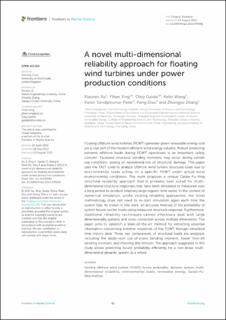| dc.contributor.author | Xu, Xiaosen | |
| dc.contributor.author | Xing, Yihan | |
| dc.contributor.author | Gaidai, Oleg | |
| dc.contributor.author | Wang, Kelin | |
| dc.contributor.author | Patel, Karan Sandipkumar | |
| dc.contributor.author | Dou, Peng | |
| dc.contributor.author | Zhang, Zhongyu | |
| dc.date.accessioned | 2022-08-16T09:10:37Z | |
| dc.date.available | 2022-08-16T09:10:37Z | |
| dc.date.created | 2022-07-08T14:59:23Z | |
| dc.date.issued | 2022-08 | |
| dc.identifier.citation | Xu, X., Xing, Y., Gaidai, O., Wang, K., Sandipkumar Patel, K., Dou, P., & Zhang, Z. (2022) A novel multi-dimensional reliability approach for floating wind turbines under power production conditions. Frontiers in Marine Science, 9:970081. | en_US |
| dc.identifier.issn | 2296-7745 | |
| dc.identifier.uri | https://hdl.handle.net/11250/3012043 | |
| dc.description.abstract | Floating offshore wind turbines (FOWT) generate green renewable energy and are a vital part of the modern offshore wind energy industry. Robust predicting extreme offshore loads during FOWT operations is an important safety concern. Excessive structural bending moments may occur during certain sea conditions, posing an operational risk of structural damage. This paper uses the FAST code to analyze offshore wind turbine structural loads due to environmental loads acting on a specific FOWT under actual local environmental conditions. The work proposes a unique Gaidai-Fu-Xing structural reliability approach that is probably best suited for multi-dimensional structural responses that have been simulated or measured over a long period to produce relatively large ergodic time series. In the context of numerical simulation, unlike existing reliability approaches, the novel methodology does not need to re-start simulation again each time the system fails. As shown in this work, an accurate forecast of the probability of system failure can be made using measured structural response. Furthermore, traditional reliability techniques cannot effectively deal with large dimensionality systems and cross-correction across multiple dimensions. The paper aims to establish a state-of-the-art method for extracting essential information concerning extreme responses of the FOWT through simulated time-history data. Three key components of structural loads are analyzed, including the blade-root out-of-plane bending moment, tower fore-aft bending moment, and mooring line tension. The approach suggested in this study allows predicting failure probability efficiently for a non-linear multi-dimensional dynamic system as a whole. | en_US |
| dc.language.iso | eng | en_US |
| dc.publisher | Frontiers Media S.A | en_US |
| dc.rights | Navngivelse 4.0 Internasjonal | * |
| dc.rights.uri | http://creativecommons.org/licenses/by/4.0/deed.no | * |
| dc.subject | vindturbiner | en_US |
| dc.subject | flytende vindturbiner | en_US |
| dc.subject | fornybar energi | en_US |
| dc.title | A novel multi-dimensional reliability approach for floating wind turbines under power production conditions | en_US |
| dc.type | Peer reviewed | en_US |
| dc.type | Journal article | en_US |
| dc.description.version | publishedVersion | en_US |
| dc.rights.holder | © 2022 Xu, Xing, Gaidai, Wang, Patel, Dou and Zhang | en_US |
| dc.subject.nsi | VDP::Teknologi: 500::Marin teknologi: 580 | en_US |
| dc.source.volume | 9 | en_US |
| dc.source.journal | Frontiers in Marine Science | en_US |
| dc.identifier.doi | 10.3389/fmars.2022.970081 | |
| dc.identifier.cristin | 2037731 | |
| cristin.ispublished | true | |
| cristin.fulltext | postprint | |
| cristin.qualitycode | 1 | |

